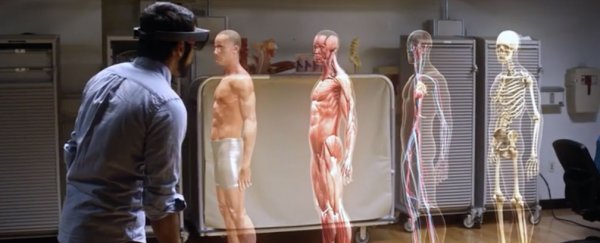Microsoft's ambitious HoloLens project has generated a huge amount of interest of late, and for good reason. Who doesn't love the idea of viewing and interacting with 3D holograms brought to life right in front of your eyes? The applications for entertainment and gaming are off the charts, but the implications for augmented reality in education and science are also undoubtedly massive.
And now, Microsoft has teamed up with Case Western University in the US to show us what this might look like in an actual human anatomy class video demonstration.
Human anatomy has been taught via two-dimensional representations of body parts for centuries, and even though in more recent times computer software has introduced various kinds of pseudo–3D anatomical models on 2D displays, none of these can rival the interactive holograms that HoloLens is capable of projecting (to the viewer's eyes, at least).
"With HoloLens, you can see the muscles on top of the skeleton, all at the same time. You can bring them in and out, and exactly understand where things sit," says Mark Griswold, from the university's radiology department.
"You can take any anatomical part and show any of it," adds Satyam Ghodasara, a medical student studying at the university. "You can move it around, you can make it kind of translucent so you can see through the outside, and that really helped me understand how cardiac anatomy worked."
The holograms will also enable anatomy and medicine students to learn things they wouldn't be able to learn from studying living people. Bodily organs can be viewed and interacted with in isolation from other parts of the body, helping students to learn how they look and function. And importantly, if something goes wrong in a medical simulation, nobody gets hurt.
Not that HoloLens only has eyes on the sciences. The video suggests that subjects like anthropology and art history could stand to benefit from HoloLens-based lessons, but really, any academic course featuring strong visual concepts may be suitable.
Microsoft has been careful to show this time that holograms only appear in a limited portion of the wearer's vision, addressing a minor controversy over the field of view the HoloLens visor offers to the user.
In previous videos, the company seemed to imply that the 3D hologram depictions would fill the wearer's whole field of vision, which caused a few ripples when some early testers pointed out that the effect was confined to a virtual window in front of them. Although most lucky enough to have had a play with HoloLens so far seem to have been blown away). Watch this space.
